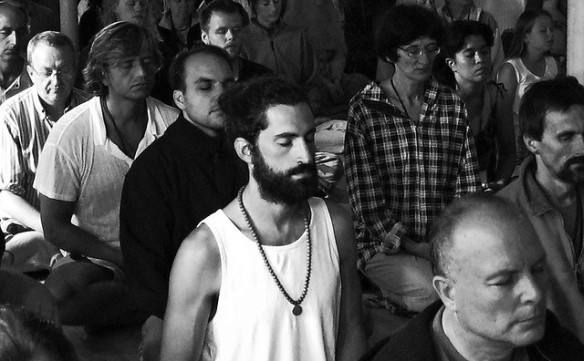On our way back from a visit to Dharma Realm Monastery in Liugui, a rural district of Kaohsiung, Taiwan, our local host took us to visit another Buddhist establishment in the vicinity. This particular monastery sits half-way up one of the many hills in this mountainous region in Southern Taiwan, and like many other hill-side properties, fell victim to a particularly severe typhoon several years ago. The mountain top above the temple crumpled after days of heavy downpour and the mudslide buried or damaged significant portions of the temple.
Three years after the storm, much of the temple has been restored and even rebuilt. The grounds are spotless –residents and volunteers dust and mop daily, even the outdoor area and we are asked to leave our shoes at the front gate. The complex has a layout of a traditional Buddhist monastery, with a series of halls housing statues of different sages on an axis and a courtyard in the middle, and flanked by residential quarters for nuns and guests on two sides.
Although I have been practicing Buddhism for nearly twenty years, and am no stranger to Buddhist iconography, architecture, and monastic setting, a surprisingly familiar uneasiness crept up in my mind as I walked through these well-adorned halls. Towering statues in these halls left little floor space for people to practice. Further, on this beautiful early summer afternoon, the temple was eerily quiet–no one was meditating, chanting or bowing anywhere. The handful of people who were around seemed to be like us–visitors, even tourists, admiring this clean, colorful, and well-decorated temple.
The uneasiness I felt is similar to the one I felt when I was a child ….
Overall, the temple felt more like a museum of Buddhist arts or a memorial shrine for the sages than a Bodhimanda –a sanctuary for learning and practicing the Buddha’s teachings and wrestling with our minds. Although my senses were overwhelmed with beautiful and towering statues, well-appointed halls, and colorful and exotic images, the whole environment felt sterile. The uneasiness I felt is similar to the one I felt when I was a child when I entered Buddhist and Taoist temples, only that I lacked the ability to describe it then.
The Buddha taught that all of us are whole and complete, and that the source of dissatisfaction is the thought and feeling that somehow we are not, that we lack something, and need to seek something to fill this perceived void.
This uneasiness is perhaps the manifestation of the alienation that takes place when I place my attention, focus, authority, and power externally versus internally. The Buddha taught that all of us are whole and complete, and that the source of dissatisfaction is the thought and feeling that somehow we are not, that we lack something, and need to seek something to fill this perceived void. Buddhist practices then, aim to help us pull our senses, focus, and attention back, and re-place the power of change within. Ironically, the towering and disproportionally large statues and well-adorned halls place the focus and authority outside, especially for the unseasoned practitioners. In addition, the lack of floor spaces in the halls pushes people out of the door only to look in and admire, instead of practicing inside of it.
I believe the Buddha lived and taught not because he wanted to be remembered as a hero forever, or to inspire beautiful art, but that people will try the tools he left behind to uncover our inherent wisdom. Beautiful and well-constructed statues and buildings can serve to inspire people to inquire and engage in spiritual practices, but only if living models exist to embody those teachings and practices alongside them. In fact, it’s the continued teaching, practicing, and embodying of the Buddha’s words that will give meaning to statues and buildings, and help to make Buddhism relevant for today’s people. Otherwise, these beautiful statues and buildings will only impress them as foreign, antiquated, exotic, superstitious, and worse, meaningless.


